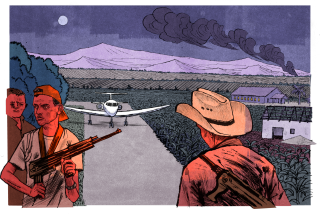Colombia coca production declined, U.N. study says
Acreage dedicated by Colombian farmers to growing coca, the illicit raw material of cocaine, fell 15% in 2010, the third straight annual drop, according to a U.N. study released Thursday.
The United Nations Office of Drugs and Crime estimated the nation’s coca crop at 155,000 acres, down from 182,500 acres in 2009. Colombian officials said the reduction reflected progress in the country’s decade-long battle against drug trafficking, an effort funded by billions of dollars in U.S. aid under a program known as Plan Colombia.
The annual survey found less encouraging results in neighboring Peru, where the coca crop rose for a third straight year in 2010, to 153,000 acres, just shy of Colombia’s world-leading level. Bolivia’s coca production also continued to creep up.
The report found the U.S. cocaine market had seen “massive declines” in recent years, although the U.S. was still the largest cocaine market, accounting for 157 tons of cocaine in 2009, or $37 billion in sales. European sales were estimated at $36 billion.
Aldo Lale-Demoz, the U.N. agency representative in Colombia, credited aerial and manual eradication as well as alternative crop programs that now include 130,000 families for the decline. Overall coca farming in Latin America has been dropping over the last decade.
“We’re doing very well, but we can’t lower our guard,” Colombian Interior Minister German Vargas Lleras said at a news conference. He warned that coca is being grown in areas rarely seen before, including reservations for indigenous people and environmentally sensitive national parks, including the rain forests of the Panama isthmus.
According to the survey, about 380 tons of cocaine were produced in Colombia last year, down from 450 tons the year before. Colombia is thought to have produced 705 tons of cocaine as recently as 2005. Drug seizures declined to a total of 182 tons from 224 tons in 2009.
Counter-narcotics officials have warned in recent months that tougher eradication and interdiction measures in Colombia are merely pushing farmers and traffickers into neighboring countries such as Peru, which led the world in cocaine production in the 1980s before Colombia took the lead.
Drug-fueled violence is on the rise in Venezuela and Ecuador, a sign that traffickers are depending less on Colombia routes to the U.S. and European markets because of tougher law enforcement.
The 2010 coca crop in Colombia is less than half the 362,000 acres estimated in 2001, when massive eradication measures largely sponsored by U.S. taxpayers began to ramp up. Plan Colombia has funneled $7 billion in aid to fight drugs and terrorism in the country.
“In past years, we met here to confront a very hard reality,” Colombia National Police commander Gen. Oscar Naranjo said at the news conference. “These results show that Colombia has left behind forever the image of being a refuge for drug traffickers.”
Kraul is a special correspondent.
More to Read
Start your day right
Sign up for Essential California for news, features and recommendations from the L.A. Times and beyond in your inbox six days a week.
You may occasionally receive promotional content from the Los Angeles Times.






